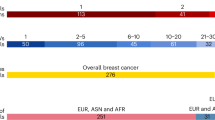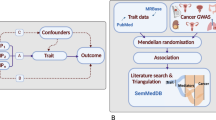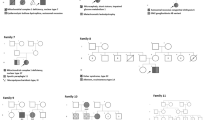Abstract
Human genetics is now at a critical juncture. The molecular methods used successfully to identify the genes underlying rare mendelian syndromes are failing to find the numerous genes causing more common, familial, non-mendelian diseases. With the human genome sequence nearing completion, new opportunities are being presented for unravelling the complex genetic basis of non-mendelian disorders based on large-scale genome-wide studies. Considerable debate has arisen regarding the best approach to take. In this review I discuss these issues, together with suggestions for optimal post-genome strategies.
This is a preview of subscription content, access via your institution
Access options
Subscribe to this journal
Receive 51 print issues and online access
$199.00 per year
only $3.90 per issue
Buy this article
- Purchase on SpringerLink
- Instant access to full article PDF
Prices may be subject to local taxes which are calculated during checkout





Similar content being viewed by others
References
Vogel, F. & Motulsky, A. G. Human Genetics: Problems and Approaches (Springer, Berlin, 1982).
Penrose, L. S. Some practical considerations in testing for genetic linkage in sib data. Ohio J. Sci. 39, 291–296 (1939).
Clarke, C. A. et al. ABO blood groups and secretor character in duodenal ulcer . Br. Med. J. 2, 725–731 (1956).
Curtis, D. Use of siblings as controls in case-control association studies. Am. J. Hum. Genet. 61, 319–333 (1997).
Spielman, R. S. & Ewens, W. J. A sibship based test for linkage in the presence of association: the sib transmission/disequilibrium test. Am. J. Hum. Genet. 62, 450– 458 (1998).
Boehnke, M. & Langefeld, C. D. Genetic association mapping based on discordant sib pairs: the discordant-alleles test. Am. J. Hum. Genet. 62, 950–961 (1998).
Risch, N. & Teng, J. The relative poser of family-based and case-control designs for association studies of complex human diseases. I. DNA pooling. Genome Res. 8, 1273– 1288 (1998).
Schaid, D. J. & Rowland, C. Use of parents, sibs and unrelated controls for detection of associations between genetic markers and disease . Am. J. Hum. Genet. 63, 1492– 1506 (1998).
Botstein, D., White, R. L., Skolnick, M. & Davis, R. W. Construction of a genetic linkage map in man using restriction fragment length polymorphisms. Am. J. Hum. Genet. 32, 314 –331 (1980).
Weber, J. L. & May, P. E. Abundant class of human DNA polymorphisms which can be typed using the polymerase chain reaction. Am. J. Hum. Genet. 44, 388–396 (1989).
Litt, M. & Luty, J. A. A hypervariable microsatellite revealed by in vitro amplification of a dinucleotide repeat within the cardiac muscle actin gene. Am. J. Hum. Genet. 44, 397– 401 (1989).
Rao, D. C., Keats, B. J. B., Morton, N. E., Yee, S. & Lew, R. Variability of human linkage data. Am. J. Hum. Genet. 30, 516–529 (1978).
Morton, N. E. Sequential tests for the detection of linkage. Am. J. Hum. Genet. 7, 277–318 ( 1955).
Ott, J. Analysis of Human Genetic Linkage (Johns Hopkins University Press, Baltimore, 1991).
Concannon, P. et al. A second-generation screen of the human genome for susceptibility to insulin-dependent diabetes mellitus. Nature Genet. 19, 292 (1998).
Risch, N. & Zhang, H. Extreme discordant sib pairs for mapping quantitative trait loci in humans. Science 268, 1584–1589 (1998).
Eaves, L. & Meyer, J. Locating human quantitative trait loci: guidelines for the selection of sibling pairs for genotyping. Behav. Genet. 24, 443–455 (1994).
Terwilliger, J. D., Zollner, S., Laan, M. & Paabo, S. Mapping genes though the use of linkage disequilibrium generated by genetic drift: ‘drift mapping’ in small populations with no demographic expansion. Hum. Hered. 48, 138–154 (1998).
Risch, N. & Merikangas, K. The future of genetic studies of complex human diseases. Science 273, 1516–1517 (1996).
Collins, F. S., Guyer, M. S. & Chakravarti, A. Variations on a theme: cataloging human DNA sequence variation. Science 278, 1580– 1581 (1997).
Kruglak, L. Prospects for whole-genome linkage disequilibrium mapping of common disease genes. Nature Genet. 22, 139– 144 (1998).
Laan, M. & Paabo, S. Demographic history and linkage disequilibrium in human populations. Nature Genet. 17, 435–438 (1997).
Lonjou, C., Collins, A. & Morton, N.E. Allelic association between marker loci. Proc. Natl Acad. Sci. USA 96, 1621– 1626 (1999).
Wright, A. F., Carothers, A. D. & Pirastu, M. Population choice in mapping genes for complex diseases . Nature Genet. 23, 397– 404 (1999).
Muller-Myhsok, B. & Abel, L. Genetic analysis of complex diseases. Science 275, 1328– 1329 (1997).
Tu, I.-P & Whittemore, A. S. Power of association and linkage tests when the disease alleles are unobserved. Am. J. Hum. Genet. 64, 641–649 ( 1999).
Nickerson, D. A et al. DNA sequence diversity in a 9.7kb region of the human lipoprotein lipase gene. Nature Genet. 19, 233– 240 (1998).
Arnheim, N., Strange, C. & Erlich, H. Use of pooled DNA samples to detect linkage disequilibrium of polymorphic restriction fragments and human disease: studies of the HLA class II loci. Proc. Natl Acad. Sci. USA 82, 6970–6974 (1985).
Carmi, R. et al. Use of DNA pooling strategy to identify a human obesity syndrome locus on chromosome 15. Hum. Mol. Genet. 3, 1331–1335 (1995).
Barcellos, L. F. et al. Association mapping of disease loci by use of a pooled DNA genomic screen. Am. J. Hum. Genet. 61, 734 –747 (1997).
Cargill, M. et al. Characterization of single-nucleotide polymorphisms in coding regions of human genes. Nature Genet. 22, 231–238 (1999).
Halushka, M. K. et al. Patterns of single-nucleotide polymorphisms in candidate genes for blood-pressure homeostasis. Nature Genet. 22, 239–247 (1999).
Falk, C. T. & Rubinstein, P. Haplotype relative risks: an easy reliable way to construct a proper control sample for risk calculations . Ann. Hum. Genet. 51, 227– 233 (1987).
Terwilliger, J. D. & Ott, J. A haplotype-based “haplotype-relative risk” approach to detecting allelic associations . Hum. Hered. 42, 337–346 (1992).
Spielman, R. S. McGinnis, R. E. & Ewens, W. J. Transmission test for linkage disequilibrium: The insulin gene region and insulin-dependent diabetes mellitus (IDDM). Am. J. Hum. Genet. 52, 506–516 (1993).
Thomson, G. Mapping disease genes: family-based association studies. Am. J. Hum. Genet. 57, 487–498 (1995).
Teng, J. & Risch, N. The relative power of family-based and case-control designs for linkage disequilibrium studies of complex human diseases. II. Individual genotyping. Genome Res. 9, 234–241 (1999).
Morton, N. E. & Collins, A. Tests and estimates of allelic association in complex inheritance. Proc. Natl Acad. Sci. USA 95 , 11389–11393 (1998).
Pritchard, J. K. & Rosenberg, N. A. Use of unlinked genetic markers to detect population stratification in association studies . Am. J. Hum. Genet. 65, 220– 228 (1999).
Devlin, B. & Roeder, K. Genomic control for association studies . Biometrics 55, 997–1004 (1999).
Feder, J. N. et al. A novel MHC class 1-like gene is mutated in patients with hereditary haemochromatosis. Nature Genet. 13, 399–408 (1996).
Farrer, L. A. et al. Effects of age, sex and ethnicity on the association between apolipoprotein E genotype and Alzheimer's disease. A meta-analysis. APOE and Alzheimer Disease Meta Analysis Consortium. J. Am. Med. Assoc. 278, 1349–1356 ( 1997).
Mignot, E. et al. DZB1*0602 and DQA1*0102 (DQ1) are better markers than DR2 for narcolepsy in Caucasian and Black Americans . Sleep 17, S60–S67 (1994).
Kempthorne, O. An Introduction to Genetic Statistics (Iowa Univ. Press, Ames, 1969).
Khoury, M. J., Beaty, T. H. & Cohen, B. H. Fundamentals of Genetic Epidemiology (Oxford University Press, New York, 1993).
Risch, N. Linkage strategies for genetically complex traits. I. Multi-locus models. Am. J. Hum. Genet. 46, 222–228 (1990).
Lander, E. & Kruglak, L. Genetic dissection of complex traits: guidelines for interpreting and reporting linkage results. Nature Genet. 11, 241–247 ( 1995).
Author information
Authors and Affiliations
Rights and permissions
About this article
Cite this article
Risch, N. Searching for genetic determinants in the new millennium. Nature 405, 847–856 (2000). https://doi.org/10.1038/35015718
Issue Date:
DOI: https://doi.org/10.1038/35015718
This article is cited by
-
New neural network classification method for individuals ancestry prediction from SNPs data
BioData Mining (2021)
-
Deep learning for cancer type classification and driver gene identification
BMC Bioinformatics (2021)
-
Case-control study on the association between the GATA2 gene and premature myocardial infarction in the Iranian population
Herz (2021)
-
Machine learning analysis of exome trios to contrast the genomic architecture of autism and schizophrenia
BMC Psychiatry (2020)
-
Towards reproducible computational drug discovery
Journal of Cheminformatics (2020)



